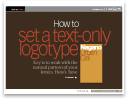
Ever come across a design that you treat differently just because you enjoy looking at it? For me, this Aquage bottle is one of those. My other products live in the closet, but this one stays out, brightening every day with its colors, gel bubbles, and especially its logotype, which is a beautiful blend of simplicity, lightness and flow.
Aquage begins as an off-the-shelf typeface — Helvetica Neue Ultra Light Extended — set tightly in lowercase. Helvetica is feminine and fashiony — light, airy, and, in this setting, curvy; aquage has no straight or angled letters (like kwx). Helvetica has spiky stems, tails, and other details, however, that chop and interrupt the flow. These letters are reworked to eliminate the spikes, which transforms the otherwise ordinary setting into a beautiful logotype. Smart!
Helvetica Neue Extended Ultra Light:
Round off the spikes:
Shorten the tail: 
The beautiful, smoothly flowing result: 

Type alone makes great logos — many of the world’s most famous, in fact! That’s great news for the less-than-artistic among us. To learn (much) more about creating text-only logotypes, get a copy of Before & After article 0660, or read it in your Master Collection DVD.





Although I agree with you, John, about the greatness of the conceptional idea behind this logo made of modified letters, I must state that the realisation of it is inferior.
At a closer look, one letter seems to be very unbalanced after the removal of the “spikes”: it’s the “a”. It looks amputated and has a tendency to tilt to the right side. IMHO, it should have been modified so that it’s equal to the left side: mirroring it would have achieved that with a few clicks. They should have spent more attention to the key letter of this logo: it’s the initial letter and the only letter that appears twice.
And the “g” does not integrate perfectly between the other letters as well. It’s the position of the body of the “g”: it does not share the same baseline as every other letter in this logo. I know that lifting it from the baseline generally is a necessary visual thing to do, and this is made on purpose. But in this case, I believe that taking an “o” from the same font and adding the “g” tail at it might have been the better solution.
Absolutely lovely logo. I love type!
This is a really good treatment for this logo; however, it should read the other way.
I love this explanation but am wondering why the “e” got left out of the makeover. It has a straight line and corner, and it could have had the same rounding treatment applied. I like how it looks, however. Is this because it adds a bit of contrast?
Thanks!
I noticed that as well . . . flipping the “a” would have achieved that quickly and easily.
Great points, John. I love when this just works. I know this was well thought out and precise, even when it looks so simple on the surface.
The K.I.S.S. method works well, works often.
I find this too hard to read. Olwen may be right that it should read the other way, although this is how book spines are printed.
But the aqua looked to me like enbe (because my brain tried reading it the other way). The lack of serifs disorients, and rotating from horizontal pushes it over the edge for me.
Worth noting that a good designer (read type artist/typographer) knows how to line up type and round off the font and make complex design decisions look easy, minimal and natural.
Nice exercise. And although I liked the original as John breaks it down, I found myself agreeing with the other comments about the “a,” “g,” and “e.” I’ve played with fonts for logotypes in the past, and sometimes there is a point where the letter is abstracted just enough to stop it from reading properly, and often it is quite a fine line.
Actually, although I like the logotype, where it falls down for me is the pronunciation. Parts of the word jump out at me — like aqua, age, and quag (!). Even though the last isn’t much of a word (short for quagmire perhaps), it messes with my thinking on how to pronounce it, and it leaves me wondering how easy it might be to explain to somebody. If I hadn’t seen the bottle and my wife asked me to go and buy some aquage, would I be able to find it — or ask for it? :-)